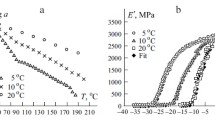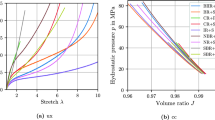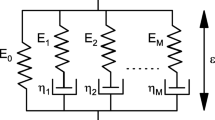Abstract
The present work presents a general approach for viscoelastic material characterization. The standard solid model and the fractional Zener model are taken into consideration. Model calibration is performed under the formalism of the inverse problems. Model validation and model selection are guided by the philosophy of the verification and validation field. Comparisons between measured data and model predictions take model uncertainties into account through Monte Carlo simulation analysis. This approach is used to calibrate models for two diglycidyl ether of bisphenol A (DGEBA) based epoxy systems modified by the incorporation of hydroxyl-terminated polybutadiene (HTPB), namely: DGEBA/HTPB blend (EPH) and DGEBA/HTPB blend modified with NCO groups (EPI). Three different types of tests are considered and a large group of test specimens are analyzed. The constitutive models are used to provide predictions for the loss factor of the materials as well as their confidence intervals. Predictions indicate that EPI presents better performance concerning mechanical energy dissipation than EPH which is highly correlated with the fact that EPI presents rubber particles distributed uniformly in nanometric scale within the epoxy matrix.













Similar content being viewed by others
References
Wineman AS, Rajagopal KR (2000) Mechanical response of polymers. Cambridge University Press, Cambridge
Pascault J-P, Williams RJJ (2010) Epoxy polymers: new materials and innovations. Wiley
Ozdemir NG, Zhang T, Hadavinia H, Aspin I, Wang J (2015) Rheological properties, cure characteristics and morphology of acrylonitrile-based nanorubber modified epoxy. J Appl Polym Sci 132(18):41911
Zheng S (2010) Nanostructured epoxy systems by use of block copolymers. In: Pascault JP, Williams RJJ (ed) Epoxy polymers. Wiley
Thomas R, Boudenne A, Ibos L, Candau Y, Thomas S (2010) Thermophysical properties of CTBN and HTPB liquid rubber modified epoxy blends. J Appl Polym Sci 116:3232
Shukla SK, Srivastava D (2006) Blends of modified epoxy resins and carboxyl-terminated polybutadiene. J Appl Polym Sci 100:1802
Soares BG, Dahmouche K, Lima VD, Silva AA, Caplan SPC, Barcia FL (2001) Characterization of nanostructured epoxy networks modified with isocyanate-terminated liquid polybutadiene. J Coll Interface Sci 358:338–346
Barcia FLB, Soares BG, Sampaio E (2004) Adhesive properties of epoxy resin modified by end-functionalized liquid polybutadiene. J Appl Polym Sci 93(5):2370–2378
Mainardi F (2005) Fractional calculus and waves in linear viscoelasticity. Imperial College, London
Beck KJ, Arnold VJ (1977) Parameter estimation in engineering and science. Wiley, New York
Kaipio J, Somersalo E (2005) Statistical and computational inverse problems. Springer, New York
Aster RC, Borchers C and Thurber CH (2013), Parameter Estimation and Inverse Problems. Second Edition. Academic Press
Oberkampf WL, Barone MF (2006) Measurements of agreement between computational and experiment: validation metrics. J Comput Phys 217:5–36
Robert CP, Casella G (2005) Monte Carlo statistical methods, Second edn. Springer, New York, USA
AIAA-G-077 (1998) Guide for verification and validation of computational fluid dynamics simulations. AIAA, VA, USA
ASME V&V 10–2006 (2006) Guide for verification and validation in computational solid mechanics. ASME, New York, USA
ASTM D638–10(2010) Standard test method for tensile properties of plastics. ASTM, Pennsylvania, USA
ASTM D2990–01(2001) Standard test methods for tensile, compressive, and flexural and creep-rupture of plastics. ASTM, Pennsylvania, USA
Costa Mattos HS, Martins SA (2013) Plastic behaviour of an epoxy polymer under cyclic tension. Polym Test 32:1–8
Lion A (1997) On the thermodynamics of fractional damping elements. Contin Mech Thermodyn 9:83–96
Borges FCL, Castello DA, Magluta C, Rochinha FA, Roitman N (2015) An experimental assessment of internal variables constitutive models for viscoelastic materials. Mech Syst Signal Process (s50–s51):27-40
Christensen R (2003) Theory of viscoelasticity. Dover, New York
Yin D, Duan X, Zhou X, Li Y (2014) Time-based fractional longitudinal-transverse strain model for viscoelastic solids. Mech Time Depend Mater 18:329–337
Zhang G, Yang H, Xu Y (2015) A surrogate-model-based identification of fractional viscoelastic constitutive parameters. Mech Time Depend Mater 1:1–19
Ghoreishy MHR, Firouzbakht M, Naderi G (2014) Parameter determination and experimental verification of Bergstr\(\ddot{o}\)m-Boyce hysteresis model for rubber compounds reinforced by carbon black blends. Mater Des 53:457–465
Podlubny I (2000) Matrix approach to discrete fractional calculus.Fract Calculus ApplInt J Theory Appl 34:359–386
Li W, Chen W, Jiang Z, Lu Z, Liu Y (2014) New validation metrics for models with multiple correlated responses. Reliab Eng Syst Saf 127:1–11
Ling Y, Mahadevan S (2013) Quantitative model validation techniques: new insights. Reliab Eng Syst Saf 111:217–231
Smith RC (2014) Uncertainty quantification: theory, implementation and applications. SIAM, Philadelphia, PA, USA
Kiranyaz S, Ince T, Gabbouj M (2014) Multidimensional particle swarm optimization for machine learning and pattern recognition. Conference on Neural Networks (ed), vol 4. Springer, Berlin, Heidelberg
Podlubny I (1999) Fractional differential equations. Academic, San Diego, California, USA
Wollscheid D, Lion A (2014) The benefit of fractional derivatives in modelling the dynamics of filler-reinforced rubber under large strains: a comparison with the Maxwell-element approach. Comput Mech 53:1015–1031
Tschogel NW, Knauss WG, Emri I (2002) Poisson’s ratio in linear viscoelasticity—a critical review. Mech Time Depend Mater 6:3–51
Lakes RS, Wineman A (2006) On Poisson’s ratio in linearly viscoelastic solids. J Elast 85:45–63
Acknowledgments
The authors would like to express their gratitude to the National Council for Scientific and Technological Development (CNPq) for its financial support under Grant Number 483391/2013, to Coordenação de Aperfeicoamento de Pessoal de Nivel Superior (CAPES) for its financial support under Grant Number AUXPE n 1197/2014, to the National Foundation of Studies and Projects (FINEP) for its financial support under Grant Number 01.12.0226.00.
Author information
Authors and Affiliations
Corresponding author
Additional information
Technical Editor: Eduardo Alberto Fancello.
Rights and permissions
About this article
Cite this article
Castello, D.A., Borges, L.A., Santos, V.O.B. et al. A general approach for viscoelastic model validation applied on the analyses of epoxy resin modified by end-functionalized liquid polybutadiene. J Braz. Soc. Mech. Sci. Eng. 39, 993–1007 (2017). https://doi.org/10.1007/s40430-016-0565-z
Received:
Accepted:
Published:
Issue Date:
DOI: https://doi.org/10.1007/s40430-016-0565-z
Keywords
- Viscoelasticity
- Fractional Zener model
- Model validation
- Uncertainties
- Monte Carlo simulation
- Epoxy resin modified




